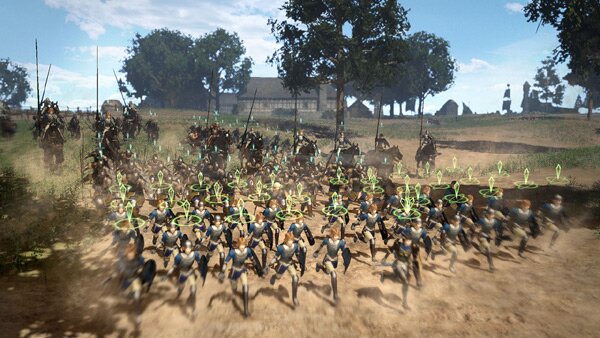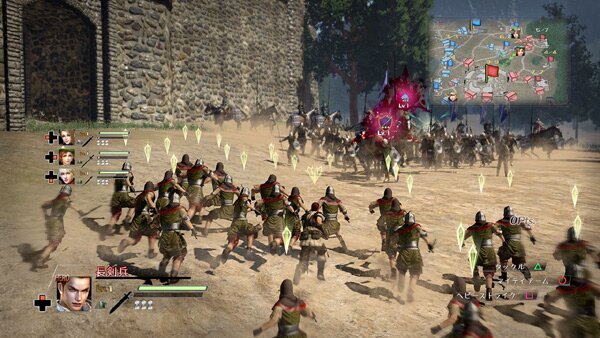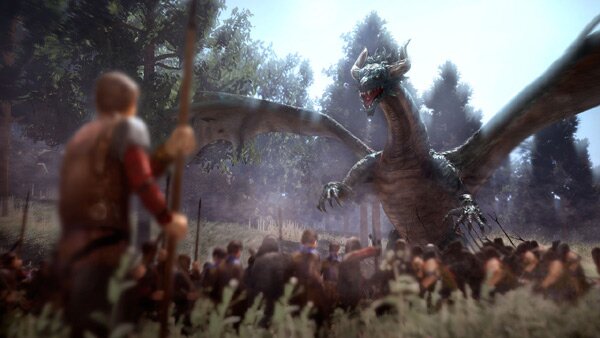Game Info
GAME NAME: Bladestorm: Nightmare
DEVELOPER(S): Omega Force
PUBLISHER(S): Koei
PLATFORM(S): PS3, PS4 (tested), XBox One
GENRE(S): Hack’n’slash, musuo
RELEASE DATE(S): 3/17/2015
Omega Force’s Bladestorm: Nightmare is a re-release of the one-and-done Bladestorm: The Hundred Years War from 2007. In classic musuo fashion, you are pitted against thousands of opponents while attempting to capture locations, secure objectives, and keep your named allies alive. Set during the Hundred-Years War between France and England, your mercenary (or band of mercenaries) is out to get rich and famous by killing lots of Europeans.
The gameplay of Bladestorm is slightly tweaked from your average Dynasty Warriors. In the Dynasty Warriors series, you’re basically a god – there is little that can harm you, your attacks contain far more flourishes, and you get the best hats and outfits. (Tecmo-Koei will also nickel-and-dime you to death with DLC.) However, Bladestorm’s combat comes from a different approach. You, individually, are pathetically weak. Charging into battle all Dynasty Warriors-style will get you immediately killed. Instead, you can command squads – either ones you yourself have, or ones employed by the nation you’re currently working for – to do your bidding. These have a sort of rock-paper-scissors dynamic.
Archers are strong against slow melee units, but crumble when anyone closes their range. More elite troops, such as halberdiers, can do massive damage to cavalry… and nobody else. Although there are a few overpowered combos – cavalry alone can get you far in the game, as long as you stay away from polearm infantry – it’s a very refreshing take on the genre. Playing as a mercenary also allows you to replay battles from both sides, although that can get confusing as to remembering who to attack this time.
Leveling and unlocking new squad types to command adds a surprisingly robust RPG element to the game as well, letting you level up your individual squad types with better equipment, more troops, and powerful attacks. It also expands troop types – such as the aforementioned cavalry having swords, javelins, or classic lances which totally own on the battlefield.
Gameplay is divided into short multi-day campaigns, where regular missions have you capturing territory. This is done by invading a town or castle and forcibly removing its occupants. The story missions are usually a bit more involved, generally requiring a concerted assault with some NPCs. Escort missions crop up from time to time as well, and are as annoying as always. Protecting defenseless supply caravans is a particularly bland one. These story-driving missions aren’t always available though, so much of your playtime will be spent in the more skirmish-style mode of territory capture. Although this could get old quickly (and did in the original version), the addition of multiplayer makes these missions more palatable.
It’s unfortunate that the multiplayer is so unintuitive, because it’s quite good fun. There are no lobbies – getting in to a match requires you to either plan ahead with a friend, or hope that someone set their game to accept new players, but is still sitting in the ready screen. There’s no drop-in, no lobby service, and matchmaking is about as poor as it can be. Connections take a while, and after a mission, you are very abruptly disconnected – so if you had fun with the person, make sure they know you’re not kicking them. But when it all finally works, online runs very smoothly. Voice chat is lag-free and crisp, all the better to plot strategy.
The game’s focus on skirmishes rather than all story-driven battles is also handy in multiplayer, since every encounter is an opportunity to gain experience and money without jumping ahead in the plot. This is a welcome relief from other multiplayer modes done by Omega Force, which are either entirely separate from the main content, or are walled off to people who haven’t beaten particular stages.
In addition to the original 2007 campaign – which covers England’s invasion, France’s rallying behind Joan of Arc, and then, suddenly, wizards – there is the included Nightmare campaign. This one sees an alternate reality where Joan of Arc commands a demon army, complete with goblins, spectres, and dragons. Again, it’s an interesting change of pace to the semi-historical musuo games Omega Force puts out – sort of a Warriors Orochi-meets-The West vibe that is a welcome diversion, and fully multiplayer integrated.
The maps, however, tend to be much larger, so make sure you have a cavalry unit to traverse France, instead of meandering through the hedge rows with a bunch of slow goblin foot soldiers. A few other additions round out the new stuff: multiplayer is very welcome (albeit tough to get into), and there’s an asynchronous mode where you can send other crafted mercenary captains off to help out other players in return for money and items. Not really a necessity, but it can be a handy diversion and net you a few rare weapons or items.
The graphics haven’t received too much of an upgrade since the original release, unfortunately. In some cases, the UI can get a bit cluttered as well – coupled with the unintuitive (there’s that word again!) interface makes for a sometimes-confusing presentation. This is particularly true in multiplayer, since the map doesn’t explicitly state where your online partner is, if he/she is in any trouble, or much else at all. And, although this may be just a colorblind person’s problem, the very high contrast logos of the varying factions are gone, replaced with more stylized, muted logos.
Although they look much better, telling England and France apart can get a bit tricky, which can lead to a cheap game-over screen. The additional processing power of the PS4 allows lots more bad guys on screen too. Audio is just fine, with just a few notes. Subs and dubs are both available, if you would like your French and English gentry to speak in Japanese. And the public house that serves as your hub connector has a bartender that mispronounces “mercenaries.” In a game centered around mercenaries, you should probably pronounce it correctly. “Mer-cen-aries,” not “mirth-en-airs.”
The Recommendation
It’s a different take on a musuo game, which may or may not be your thing, but Bladestorm: Nightmare is actually a pretty decent re-release. Tweaks to the original game and the addition of a brand new secondary campaign are worth a look, and the multiplayer is a great addition – even if it is terribly implemented. Tackling the game with a patient like-minded buddy is the best way to go here.






























